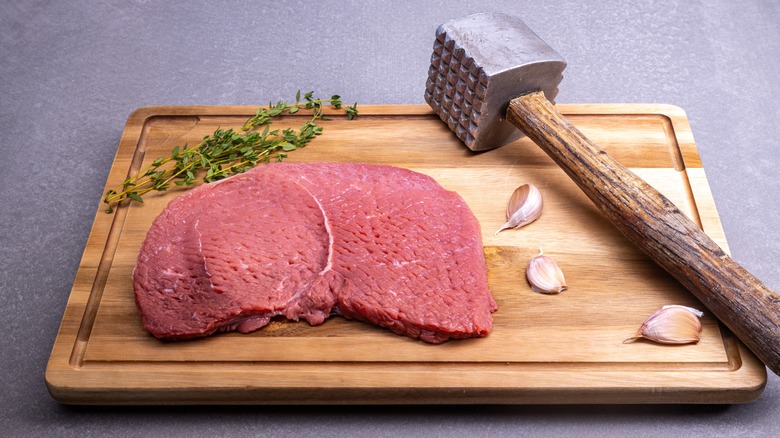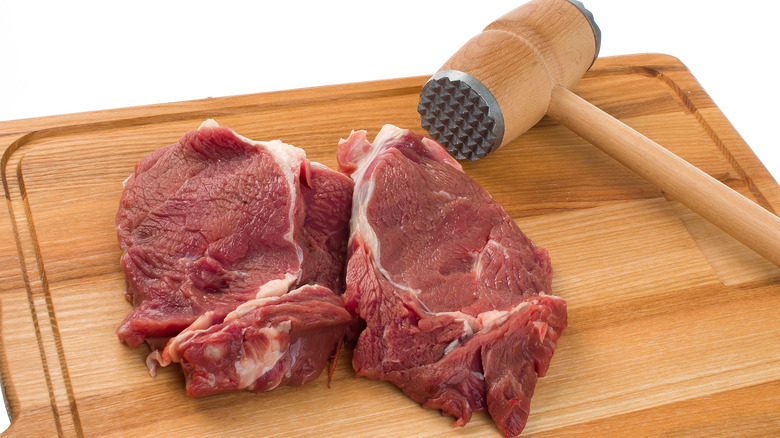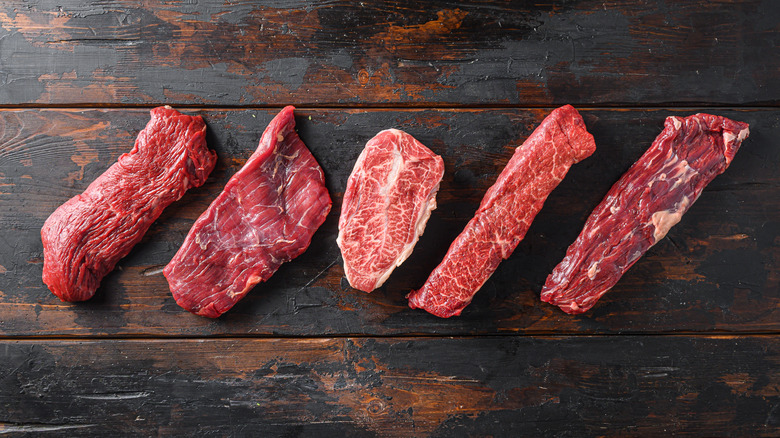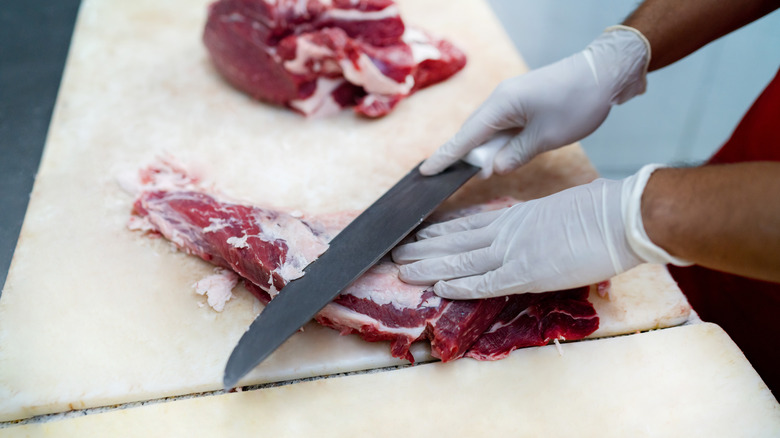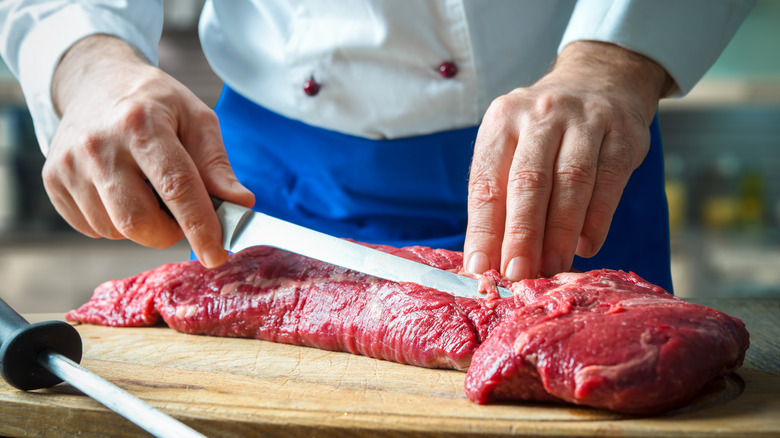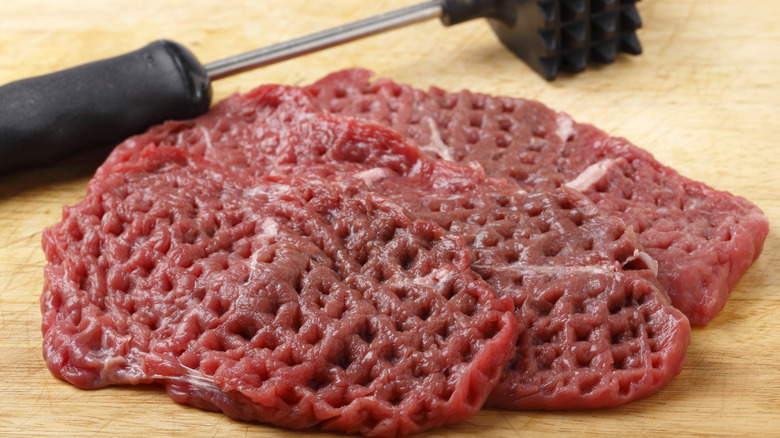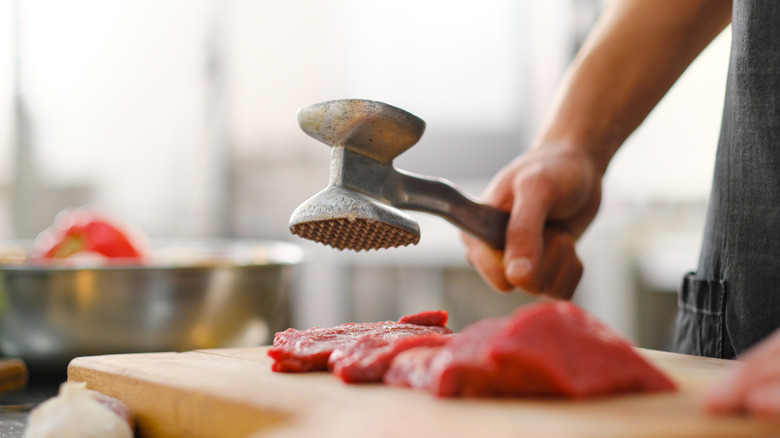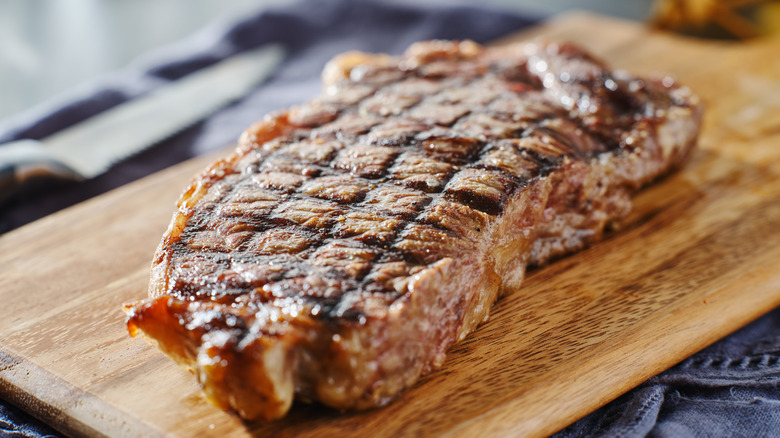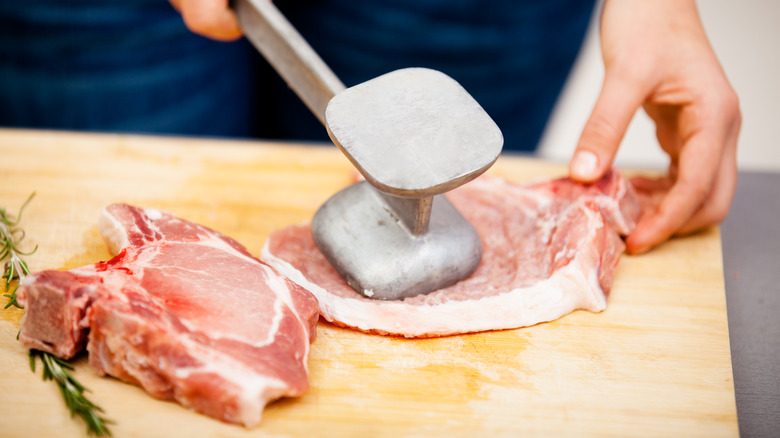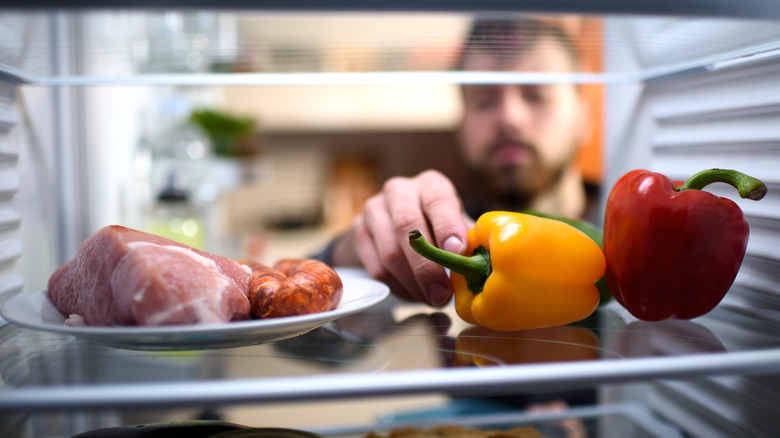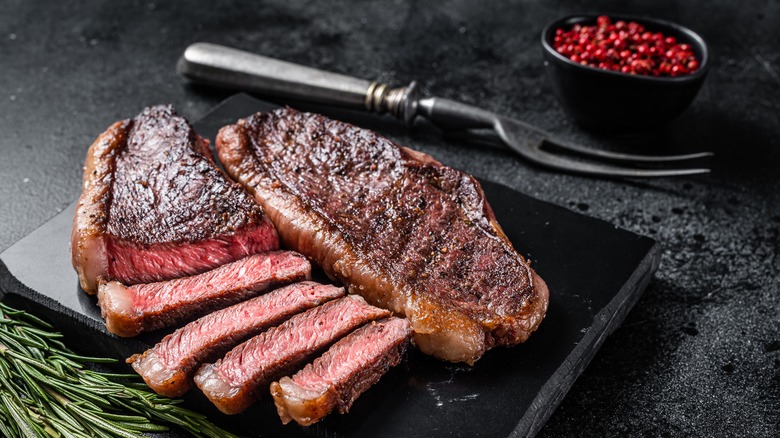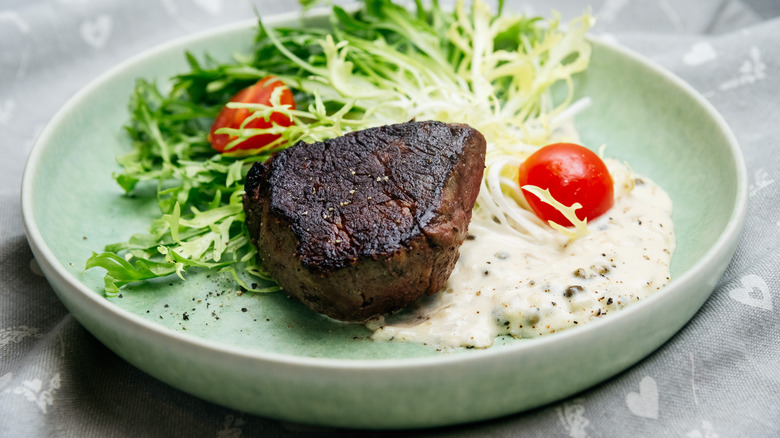12 Biggest Mistakes You're Making When Tenderizing Steak
What is the best type of steak and how should you have it cooked are both hotly debated topics. What isn't up for debate is that your steak should be juicy and tender. Tenderizing steak is a culinary science crucial for creating a delicious dish. When done right, it can transform even the toughest cuts of meat into mouthwateringly tender, flavorful masterpieces that leave your taste buds tingling. Whether you're grilling, pan-searing, or roasting, tenderizing is crucial in elevating your steak from good to extraordinary.
Tenderizing steak is important for two reasons. Firstly, it will soften the meat's texture by breaking down its muscle fibers. Secondly, tenderizing better allows any marinades, seasonings, and spices to penetrate and infuse into the steak. However, tenderizing steak takes a lot of time and effort. Due to this, it's vital that you know the common mistakes when tenderizing so that your efforts don't go to waste. From using the wrong tools to marinating for too long, each mistake can significantly impact the outcome of your dish. Let's look at the biggest pitfalls to avoid if you want a beautifully tender and delicious steak.
1. Not choosing the right method
The first mistake you can make is not considering all the ways to tenderize steak. You may choose one method, thinking it's the only way, not realizing that another tenderization technique could give you results more suited to your taste. The best example is perhaps pounding the steak with a hammer when you prefer it to be marinaded. Marination involves soaking the meat for several hours in a flavorful acidic liquid. This acidic solution will break down the fibers and infuse the meat with the taste of your marinade. For many people, this is easier than pounding the meat, but others may not like marinating as they don't want the infusion of acidic flavors.
Pounding, however, flattens the meat, which mechanically breaks down the connective tissue and muscle fibers. This is ideal for achieving a uniform thickness and for those who want to cook steak without marinade. They are the two most obvious tenderizing methods, with salting and slow cooking also being common. Added to this are a range of other solutions that are worth considering. The key is understanding which method suits your specific cut and culinary goals. You could be missing out on your preferred texture or flavor of steak by thinking you need to tenderize it in a certain way. So, choose wisely, and you'll be on your way to a new culinary excellence.
2. Using the wrong cut of steak
It's important to know that not all steaks are created equal. You probably knew that already, but not only is their fat content, shape, and taste different, but also how densely packed the muscle fibers are. A big mistake we see is thinking that you can take a tough cut of steak and make it as tender as a more prime cut. Due to this, you need to consider selecting a cut that is more likely to give you the results you're looking for. Some muscles on an animal have minimal usage, and these are generally the more tender cuts, such as tenderloin or ribeye. More active muscles will produce tougher cuts, such as flank or skirt steak.
It doesn't mean these are bad cuts of steak, but you need to appreciate what you're working with. If you still think your steaks are chewy even after your tenderization attempts, you've likely been buying tougher cuts. Simply put, no matter how meticulously you marinate, season, or cook a tough steak, it will inherently possess a chewier texture than a tender cut. Buying a naturally tender cut will enhance your chances of achieving your perfect steak. Making an informed choice in the butcher's aisle is the first step towards a delicious, tender steak that will impress your taste buds.
3. Not removing excess connective tissue
One part of a steak no one wants to eat is the connective tissue. Often referred to as sinew, this is a tough, fibrous material surrounding meat's muscles and bones. Only the slowest cooking methods can fully tenderize this tissue, and it can significantly impact the dish's quality. Most tenderizing efforts will only ever have a minimal effect on the sinew, and while the meat may be tender, too much sinew can still mean a chewy texture. Not only does it negatively affect the texture, but it also affects the flavor, as the sinew doesn't break down or absorb the seasoning.
The negative influences of connective tissue don't stop there, as it can also lead to uneven cooking, which further affects the tenderness and texture. Thankfully, this is an issue that can be easily solved. Trimming excess connective tissue is essential to create a more tender, flavorful, and evenly cooked steak. It can be easy for the untrained eye to mistake connective tissue for fat; therefore, knowing the difference is a good first step. To achieve the best results, take the time to trim away this unwanted sinew, and don't let it ruin your tenderization efforts.
4. Leaving the thickness of your steak uneven
One of the most significant advantages of pounding your steak is that it allows you to even out the thickness of your streak. For meat to be as tender as possible, it can't be overcooked, and it becomes almost impossible to cook evenly if you have a steak with uneven thickness. The problem here is obvious: Although one side of your steak may be tender, the other may be overcooked and tougher. This inconsistency in cooking can lead to less-than-desirable results. Not only will the steak be less appetizing, but it can be a food safety risk if one side has been left raw and undercooked.
There are two main solutions here. If you use a non-mechanical tenderizing method such as marinading, it's best to cut the streak and split the cooking times for a more uniform result. When using a meat hammer, you can pound the streak to make it more even and avoid cooking issues. Pounding is a good solution, but you do need to be careful not to overdo it, as you may end up with varying textures across the same steak. The bottom line is that you should never cook steak if the thickness is notably different across the cut, as you'll never get great results.
5. Over-tenderizing
Can't stand a chewy texture with your streak? If that sounds like you, you may be desperate to make your cut as tender as possible. Due to this, you may pound the meat vigorously or marinade it for days, thinking that is the key to ultimate tenderness. The reality is that it is easy to over-tenderize your meat. When this happens, that melt-in-the-mouth steak you were hoping for turns into a mushy disaster. You want to break down those tough muscle fibers, but doing it too much will lead to a loss of texture and structure. The result is a steak that lacks a satisfying chew and the meatiness that steak lovers crave.
To guard against over-tenderizing, it's essential to understand the methods and tools used. Each method has its limits and ideal duration. Overexposure to these methods or ingredients can make the meat too soft. If you want to know how to pound or marinate the steak perfectly, then make sure to keep reading. Of course, as we mentioned earlier, if you're desperate to have the most tender steak possible, it's best to buy a leaner cut rather than risk over-tenderizing a tougher steak. This will more likely give you the desired results with less time and effort.
6. Using excessive force
This links in with our previous point, but using excessive force isn't just about potentially over-tenderizing. It can result in a damaged piece of meat and potential safety hazards. Smashing down on that streak with a hammer too hard not only risks damaging equipment, but you may also damage your own muscles in the process. And as we've discussed, all that effort could be for nothing if you end up with mushy meat. To avoid this mistake, you can follow some simple steps when using a hand-powered meat tenderizer.
The first step is to ensure your steak is ready. For example, if it has been in the fridge or freezer, it needs time to reach room temperature. It's also good to pat it down to remove excess moisture. The next step is to choose the correct side of your tenderizer, as one side is likely to be flat and the other spiked. Use the flat side for thin cuts and the pointed side for thicker ones. When using the hammer, your blows should be firm but controlled. The tool's weight will do most of the work, so avoid forcefully pounding the meat. Systematically work through the steak to ensure all surfaces get an even distribution of blows for uniform results. After tenderizing one side, flip the steak and repeat the process for the other side.
7. Marinating for too short or too long
The longer your streak sits in the marinade, the more tender it will be and the more it will soak up those flavors, right? Sadly, you risk over-tenderizing your streak if you leave it soaking for too long. Not only can marinating it for too long lead to a mushy texture, but those acids it has can start to denature the meat's proteins, resulting in a mealy texture and an unpleasant aftertaste. This is why it's generally recommended not to marinade for over 24 hours. As well as marinating for too long, the process can be too quick. If you marinate steak for too short a time, you won't fully maximize the potential of the marinade.
When marinating too quickly, the flavors won't have time to penetrate the meat. The desired tenderness might not be achieved either, as the acids and enzymes in the marinade need time to break down the meat's fibers. So, how long should you marinate for? The exact answer will depend on the type of steak and the thickness of it. For thinner cuts, around 2 to 4 hours is recommended. For thicker cuts, 6 to 8 eight hours is ideal, but you can leave these overnight without issues. Experimentation can help you find the ideal time for your taste preferences and the dish you're preparing.
8. Skipping the resting period
To get a perfectly tender steak, you need to allow it to rest a couple of times. First and foremost, allowing the steak to rest after tenderizing is crucial. When you tenderize the meat, you disrupt the muscle fibers and disturb its ability to retain moisture. When given time to relax, the fibers will reabsorb that moisture, leading to a juicer and more tender steak. Letting it rest will also ensure that the meat comes to room temperature, which promotes even cooking.
However, this isn't the only time you should let the steak rest, as it's also important to do it after cooking. The muscle fibers contract when you cook a steak, and the juices are pushed toward the center. If you were to cut into the steak immediately, those juices would spill out, leaving you with a drier and less flavorful piece of meat. Allowing the steak to rest 5-10 minutes after cooking allows the juices to redistribute and reabsorb, resulting in a juicy and tender steak that retains its flavor. Patience is often the key with steak; letting it rest at crucial times can make a whole world of difference.
9. Not having the right tools
When it comes to pounding meat, various items can be used as an emergency replacement. We've heard meat being tenderized with a heavy saucepan, a regular hammer, an empty wine bottle, and even a really heavy book. These can work to an extent but with some significant drawbacks. Not only will their effectiveness be limited, but there are also some safety hazards. If you want to tenderize meat, you need to invest in the right tools, which usually aren't too expensive.
A tenderizer hammer will always be the safe bet for mechanically tenderizing meat. As mentioned above, these have both flat and spiked sides, depending on the cut you need to tenderize. Another solution is a needle tenderizer, which has multiple sharp needles that penetrate the meat. While this can be easy to use, it's only suitable for thicker cuts, and the risk of over-tenderization is high. Other tenderization methods are simply about having the right ingredients to get your desired taste and tenderness. It's important not to take shortcuts when tenderizing meat, as you risk wasting not only a good cut of steak but also your safety.
10. Cooking straight from the fridge
Cooking a steak from the fridge can affect not only the steak's texture but also the evenness of cooking. Both of these factors will impact the tenderness of the meat. When cooking directly from the refrigerator, the core of the steak will still be cold while the outer layers have already started cooking. Due to this, the streak won't cook evenly, and the likelihood is that you'll need to overcook the outside of the meat to ensure the inside is properly cooked. Achieving a uniform level of tenderness throughout the steak becomes challenging when it's cold, as the muscle fibers respond differently to heat.
Added to these factors, the steak's cold interior won't absorb the seasonings and flavors as effectively as it would if brought to room temperature first. This can lead to a lack of depth in the taste of the meat, along with inconsistency in tenderness. To avoid this mistake, it's best to let the steak sit at room temperature for about 20-30 minutes before cooking. This will also ensure it has time to rest if you've tenderized it with a meat hammer. Cooking the streak at room temperature will ensure an even level of tenderness throughout the cut.
11. Slicing with the grain
Slicing with the grain is a simple mistake but significantly affects a steak's texture and tenderness. Muscle fibers are long and will stretch from one tendon to the next. When you slice meat with the grain, you are essentially cutting alongside the muscle fibers in their full length. This approach results in longer, intact muscle fibers that can make the steak tougher to chew. The meat maintains a significant amount of its natural chewiness, which can counteract the tenderizing methods applied before or during cooking.
Slicing against the grain will sever these fibers and make them much shorter in length. This makes the meat more tender, as the muscle fibers are easier to chew through. The grain of steak is usually easy to spot, especially in tougher cuts of meat, where it's even more important to cut it properly. There should be subtle lines running in one direction up the cut. You want to cut across these lines instead of with them. With more tender cuts, the grain is harder to spot, but just ensure you're cutting across any lines it has. It makes a big difference, and you don't want your tenderization efforts to go to waste by making this simple error.
12. Overcooking the steak
We end on perhaps the most obvious point of all. Overcooking steak is undeniably one of the most significant mistakes when tenderizing. It's a culinary blunder that can turn your meticulously prepared, tenderized steak into a tough, dry, and unappetizing dish. However much effort you put into preparing your steak, overcooking will negate all your efforts to enhance its tenderness and flavor. Whatever form of tenderizing method you use, the aim is to break down the muscle fibers along with any connective tissue. However, overcooking can reverse these efforts. When you cook steak for too long, the meat's proteins denature, and the muscle fibers contract, causing the steak to become tougher and less tender.
Added to the issue of contracting muscles, the longer steak is exposed to high heat, the more moisture it loses. Overcooking will evaporate the steak's natural juices, making it even more difficult to chew and resulting in a less flavorful end product. This is particularly true of lean cuts of meat, which are more susceptible to drying out when overcooked. To avoid this mistake, it's essential to monitor the steak's cooking time and temperature closely, using a meat thermometer if you are not confident. And once you've finished cooking, ensure you give it time to rest to allow it to reabsorb those juices to keep it as tender as possible.
